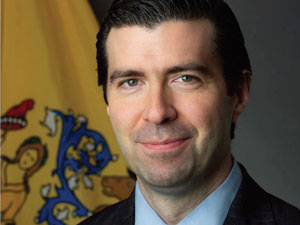Some legal arrangements were finalized over the summer, while the issue of dredging still overhangs the project
The groundbreaking on the New Jersey Wind Port on September 9, 2021 came after a flurry of other activity preparing for that event over the summer.
In August, the board of the New Jersey Economic Development Agency (NJEDA) approved a ground lease with Public Service Enterprise Group (PSEG), the energy company that owns the artificial island in the Delaware River where the port will be sited, for the purpose of building and operating the wind port. The lease is for a 28-year initial term and 78-year maximum term, covering seven parcels totaling 122 acres, at an average annual rent of $3.1 million. That lease was signed by the parties on September 14, 2021.
Also in August, the board approved a construction manager contract with AECOM Tishman, a company also involved in the construction of One World Trade Center and the Jacob Javits Convention Center in New York City, among others, after that company was awarded the contract a month earlier. Also approved was the initial budget for the first phase of preconstruction activities, which include the removal of subsurface concrete from the port site, and budget increases for financial, commercial, and technical advisory services.
NJEDA has also been involved in community outreach efforts, “helping local workers prepare for the job opportunities the project will create and guiding local businesses through the process to receive contracts for work on the port,” noted Tim Sullivan, the authority’s CEO.

Projects on the drawing boards for the port includes nearby dredging, which is due to begin in the second quarter of 2022, as well as resolving the complications that often accompany that activity. NJEDA has proposed to place dredge material into a 109-acre confined disposal facility (CDF), an area that is subject of a land exchange between the U.S. Army Corps of Engineers and PSEG. In order to make that happen, noted Sullivan, NJEDA and PSEG will need to execute a dredge placement agreement by the time NJEDA takes possession of the leased parcels.
“If an agreement is not in place by the time the authority draws down parcels it will be unable to terminate the lease for those parcels on the basis of not having a dredge placement agreement in place,” Sullivan added. “In that event, the authority would have to identify a different location to place dredge material.”
The New Jersey Board of Public Utilities and the New Jersey Department of Transportation have earmarked a total of $47 million for dredging in fiscal year 2022, while the state’s budget separately includes $200 million for the development of the wind port.
The progress made on the wind port has been significant, especially considering the fact that the project was first announced little more than a year ago. NJEDA’s Sullivan said he is confident that New Jersey’s investment in the port will fulfill its intention of “addressing the climate crisis head-on and creating thousands of good jobs” while establishing the state “as a global leader” in “one of the newest and fastest-growing industries in the world.”

Follow us on social media: